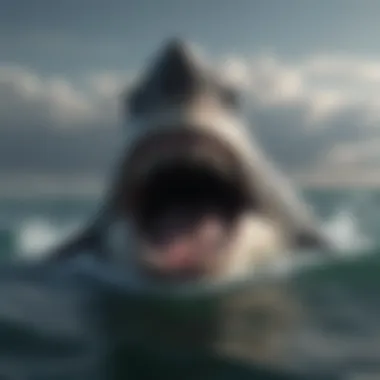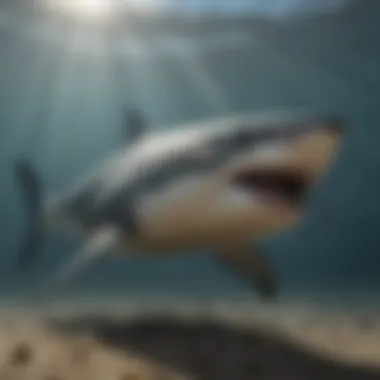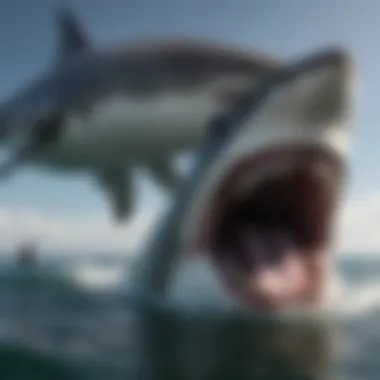Megalodon vs Great White Shark: A Comparative Study


Intro
This section embarks on a comparative analysis between the Megalodon and Great White Shark. With stunning contrasts and similarities, they stand as two remarkable apex predators of the ocean. This detailed examination will provide insights into their evolutionary history, natural behaviors, and ecological requisites, positioning them within the broader framework of marine life.
Rock and Fossil Identification
Fossils provide a window into the distant past, showcasing the ancient species and life forms that once inhabited our planet. When studying the Megalodon, we focus on specific types of fossils, essential to understanding its existence. There are distinct fossils linked with the Megalodon, often characterized by its large teeth, often double the size of the teeth found in Great White Sharks.
Types of Rocks and Fossils
- Fossilized Teeth: The most fascinating aspect is clearly the massive teeth. Megalodon teeth can exceed 7 inches in length, appearing triangular with serrated edges.
- Vertebrae Fragments: Another significant fossile apect comes from vertebral remains which help shed light on their size and lifestyle.
Characteristics to Look For
When identifying these fossils, look for the smooth surface and differentiating serrated edges in teeth. Most depictions will emphasize the size in comparing it to human hands to grasp their magnitude. Scraps of vertebra can provide shape insights reflecting the gigantic structures they supported.
Tools for Identification
Common tools include the following:
- Magnifying Glass: This helps by enabling close examination for understanding microscopic features on teeth.
- Ruler: Useful for measuring length and width to determine the potential classification of species based on size comparison.
Collecting Tips and Techniques
The pursuit of fossils is an intriguing journey. There are some practices for maximizing success during collection.
Best Practices for Collecting
- Respect Local Regulations: Know that legal rules govern the collection of fossils; ensure permissions are in place before beginning.
- Use Proper Gear: Wearing protective equipment is key to ensure safety while manipulating stones and heavy news.
Locating Prime Collecting Sites
Many sites around the world hold fossils. Coastal areas where sedimentary rocks exist offer opportunities. To cite, the Miocene deposits off the coast of North Carolina yield Megalodon remnants.
How to Safely Extract Specimens
Tools typically include:
- Hand Tools: Using chisels or hammers to uncover fossils protects the structural integrity during extraction.
- Plastic Buckets: Carrying seasoned and primed specimens avoids losses or damage while traveling.
Preservation and Display
A crucial step is ensuring newly found fossils remain intact for posterity and study.
Techniques for Preserving Rocks and Fossils
- Cleaning: Remove any debris without altering structure using brushes.
- Sealing: Use wax or polyurethane to protect surfaces, guarding against weather.
Proper Storage Methods
Make certain they’re kept in temperature-controlled environments to prevent deterioration, prioritizing non-acidic cardboard boxes for storage.
Creative Display Ideas
Create information display bases highlighting each fossil alongside an accurate depiction of its originating conflicts to offer some pedagogical value.
Geological Insights
Understanding these fossils cannot occur without engaging with geological possibilities.
Geological Formations and Processes
Studying the environment and surrounding ecosystem provides enlightening context, aiding interpretations towards habitat changes.
Historical Significance of Rocks and Fossils
Debates often arise on its significance in large species extinction trends; examining Megalodon does provide insights on shifts and turnovers during isolated epochs.
Notable Discoveries in the Field
Regular innovation occurs in fossil research. Enhanced techniques can lead to groundbreaking finds, illuminating Megalodon's place in marine evolution and the mythical appeal surrounding ancient sharks.
Through careful study of fossils, researchers can forge connections to a time when the Megalodon dominated oceans, vital for comprehending modern shark populations.


With this pair of mega-predators extensively debated across the fossil community and beyond, understanding Megalodon as well as the Great White Shark is invaluable, not just for oceanography, but for paleontological progress too.
Prologue
Understanding the Megalodon and Great White Shark is crucial for comprehending their roles in marine ecosystems and the history of marine life. These two apex predators exhibit fascinating contrasts and similarities that reveal much about evolutionary adaptation and environmental changes over time.
The Megalodon, a prehistoric giant, roamed the oceans millions of years ago, while the Great White Shark has maintained a significant presence in contemporary marine habitats. By examining their size, feeding habits, and ecological roles, we can gain insight into how they have impacted their environments.
Many people mistakenly perceive large sharks as monstrous threats; however, their existence frames more intricate narratives about biodiversity and adaptation. For rock and fossil collectors, the examination of these two species provides tangible links to understanding geological time and paleoenvironments. Recognizing their evolution not only informs us about marine biology but also unearths historical shifts in oceanic habitats.
In this exploration, we will delve into the physical traits, behavior, and survival strategies of both the Megalodon and Great White Shark. The goal is to present a multi-faceted portrayal of these creatures, stimulating interest and fostering deeper appreciation for marine life, both past and present.
While the Megalodon has been extinct for millions of years, its fossil record provides essential clues to scientists studying evolutionary history and shark biology.
This discussion aims not only to inform enthusiasts but also to inspire a deeper inquiry into marine sciences, the preservation of ocean ecosystems, and the ongoing challenges both extinct and extant species face in a constantly changing environment.
Historical Context
Understanding the historical context of both the Megalodon and the Great White Shark enriches the comparative analysis by placing these species in the framework of evolutionary biology and ecology. This section highlights key elements like fossil records, significant discoveries, and their implications on marine predation. Recognizing how these creatures have adapted to their environments over millions of years sheds light on their behavior and their current ecological roles.
Fossil Records of Megalodon
The Megalodon, scientifically known as Carcharocles megalodon, dominated ancient oceans from approximately 23 to 3.6 million years ago. The extensive fossil record illustrates its sheer size and predatory prowess. Fossils of Megalodon mainly consist of teeth, as bones are often less preserved; some captured data present teeth measuring over 7 inches in length. These colossal specimens provide critical insight into their feeding habits and muscle structure, indicating they were apex predators.
The geographical spread of these fossils is global, with discoveries made in various places such as Europe, America, and Africa. These find strengthens the understanding of the ecological parameters during Megalodon’s timeframe. Moreover, studying the morphology of teeth and other closer related specimens contribute crucial details about diet. In essence, the fossil records portray a species that was likely versatile in hunting strategies, targeting marine animals that lived in its aquatic zones.
Great White in the Modern Era
In contrast, the Great White Shark, Carcharodon carcharias, are still a extant species and are among the most researched marine organisms. It is a remarkable predator with well-documented behavior observed in coastal waters worldwide. Different populations can be reviewed in detail through tagging and tracking studies that interpret migration patterns, habitat preferences, and social behavior.
The significance of Great White Sharks in contemporary marine science cannot be overstated. Their role in research contributes widely not just to marine biology but also influences conservation efforts directly. As a guarded species, the studies involving their behavioral patterns open doors to understanding how human activities could affect both their populations and the ecosystems that depend on them.
Understanding the historical legacy of these two predators helps us comprehend the biogeographical and ecological dynamics that shaped the modern oceans.
Through this section on historical context, the stage is set for further engaging discussions that compare the two remarkable species while focusing on physical characteristics, behavior and ecological impacts that articulate their influence registered in marine history.
Anatomy and Physiology
Understanding the anatomy and physiology of the Megalodon and Great White Shark is essential in appreciating how these creatures have adapted to their environments. This section dissects key physical components and systems of both species, elucidating how their traits support survival, predation, and adaptations within varied aquatic habitats.
Size Comparisons
Megalodon is known for its impressively large size, estimated to reach lengths of over 60 feet and possibly exceeding 80 feet. In contrast, modern Great White Sharks generally grow to about 15 to 20 feet. Size not only reflects maturity but also reveals insights about the ecological roles they inhabit. Being larger, Megalodon would have needed considerable food resources and faced distinct competition from other marine predators. Great Whites, although smaller, are nonetheless formidable and active hunters.
Morphological Features
Teeth Structure
Teeth structure is a defining aspect of both the Megalodon and the Great White Shark. Megalodon had massive, serrated teeth, often measuring more than seven inches long. This characteristic enabled it to tackle enormous prey, including whales and other large marine animals. In contrast, Great Whites possess smaller, but still efficient, serrated teeth optimized for taking bites out of prey rather than demolishing them. Thus, the size and shape of teeth in both sharks serve pivotal roles in their feeding mechanics, catering to their sizes and hunting methods. The larger teeth of Megalodon made it an apex predator capable of severely damaging much larger animals. This results in profound implications for actual feeding strategies in historical marine ecosystems.
Body Shape
The body shape varies significantly between the two species. Megalodon displayed a robust, stout, and more blunt body compared to the streamlined and agile form of the Great White. The stout body of Megalodon likely contributed to powerful bursts of speed, helping it secure large prey quickly. On the other side, the hydrodynamic shape of the Great White allows for more agility and extensive roaming across diverse oceanic habitats, making it suitable for snatching fast-moving prey. Both designs reflect adaptations that benefit each species in specific ways relevant to hunting strategies and habitat explorations.
Fins and Tail
Fins and tail strength contribute to the swimming capabilities of both sharks. Megalodon's tail had considerable musculature, which served vitality in propelling its large body. In contrast, Great Whites exhibit a smaller, yet very strong, caudal fin designed for rapid accelerations; this is advantageous for ambush predation. The divergence in their fins is a reflection of respective hunting styles and environments; Megalodon’s significant tail strength implied less frequent but powerful movements to pursue large animals, while the Great White's agility and speed in the water signify a completely alternate hunting niche. This reveals information on how both species navigate their environments while feeding and fleeing from threats.
The physical differences in the anatomy and physiology of Megalodon and Great White Sharks are not trivial. They are foundational to understanding their ecological impact and behavior within their respective marine communities.
Habitat and Distribution
The habitat and distribution of Megalodon and Great White Sharks are critical to understanding their ecological roles, behaviors, and adaptations. These characteristics establish the geographical reach each species occupied, thus impacting their interaction with prey, competitors, and their environment. Examining their habitat can also provide insight into their evolutionary history and reflect changes in marine ecosystems over time. For scientists, knowing where these sharks lived significantly contributes to paleontological studies and ecological conservation efforts today.
Megalodon's Range
Megalodon thrived in a variety of marine environments during its reign approximately 23 to 2.6 million years ago. Fossil evidence suggests its range extended globally, favoring warm, shallow waters. Estuaries and coastal zones likely provided ideal nurseries for young Megalodons, allowing them to grow and develop in relative safety from larger predators. Megalodon fossils have been uncovered in regions such as the Americas, Europe, and parts of Africa, indicating its capacity to traverse vast expanses of ocean.
The adaptability of Megalodon led it to different environments, constituting a range that included continental shelves and deep waters. This preference for diverse habitats likely allowed it to exploit various available prey, cementing its position as an apex predator in ancient aquatic ecosystems.
Great White's Habitat Preferences
Contrary to Megalodon, the Great White Shark maintains a more specific set of habitat preferences. This species often inhabits temperate waters, typically ranging from the coastal waters of the United States to South Africa and Australia. Great Whites are found in cold, nutrient-rich waters where seals and other marine mammals, their primary prey, congregate. Their presence is often associated with areas of high productivity, such as continental shelves, where prey abundance can support their energetic needs.


In addition to coastal habitats, Great Whites also venture into deeper waters but prefer staying close to the surface. Their migratory patterns underscore their sensitivity to water temperature and prey movement, illustrating the delicate balance Great Whites maintain within their selected habitat. Complexity in habitat selection influences their feeding behavior, mating strategies, and even their interaction with human activities.
Diet and Feeding Behavior
The examination of diet and feeding behavior offers a critical lens through which one can comprehend the ecological roles and evolutionary adaptations of both the Megalodon and the Great White Shark. Understanding what these apex predators consume and how they hunt not only illustrates their survival mechanisms but also unveils significant insights into the marine ecosystems they inhabited and currently dominate. By analyzing their feeding habits, we unfold deeper layers of their interactions with prey and enrich our knowledge about predator-prey dynamics in the ocean.
Megalodon: Apex Predator
Megalodon, a formidable titan of the ancient oceans, reigned supreme for millions of years. Its diet likely consisted of various marine mammals, large fish, and possibly even the smaller shark species of its time. The Megalodon was exceptionally well-equipped for predation due to its formidable size and strong jaws. Its teeth, measuring up to seven inches long, were designed to slice through flesh and break bone with remarkable efficiency. This structure enabled it to tackle significant opponents, including whales. Fossil records suggest that Megalodon's hunting success depended on ambushing large prey, while using their tremendous bulk to overpower them.
Evidence has been found showing Megalodon bite marks on mammoth-sized marine animals, revealing not only its huntin prowess but also its ecological impact, as such predation played a crucial role in maintaining the balance within ancient marine communities.
Great White Feeding Techniques
The Great White Shark employs various unique feeding strategies adapted to its environment. One prominent technique for predation is the 'breaching' behavior, where a shark forces itself upward to escape water and catch unsuspecting seals or fish. This technique is visually spectacular and reflects agility that belies its size.
Moreover, Great Whites use stealth to their advantage—as ambush predators, they often rely on camouflage to blend with their environments. They have acute senses, particularly their ability to detect electromagnetic fields produced by their prey. With its sharp teeth and strong jaws, the Great White is capable of taking large bites from its prey, typically relying on gradual successes over time rather than sheer power alone.
Both species demonstrate intriguing similarities and differences in their feeding strategies, shaped by evolutionary pressures and their respective environments. Further understanding could add more to the field of marine biology, emphasizing how vital these predators are to their respective ecosystems.
The diet of apex predators like Megalodon and Great Whites dramatically influences marine ecosystems—evolution has tailored their hunting behaviors for lasting success.
Reproductive Strategies
Understanding the reproductive strategies of the Megalodon and Great White Shark is pivotal in comprehending their roles within marine ecosystems. Each species has distinct methods for reproduction that reveal significant adaptabilities to their environments. By analyzing these strategies, we can infer how these predators survived and thrived through various geological epochs.
Megalodon's Reproduction
Megalodon, known scientifically as Carcharocles megalodon, carried out one of the most fascinating reproductive strategies among ancient sea predators. This gigantic shark is thought to have been ovoviviparous, a phenomenon in which the embryos develop inside the mother's body and are nourished by egg yolk. After sufficient development, the mother gives birth to live young. Estimations suggest that a Megalodon could birth as many as 10 to 14 pups at one time. This method of reproduction allowed for a higher likelihood of survival as the young would emerge relatively large and advanced, making them less vulnerable to predation in their early stages.
Research of fossil teeth and vertebrae provides hints to the growth patterns and gestation periods of Megalodon. These details help scientists create models of how they once occupied their ecological niches effectively. This reproductive strategy indicates that Megalodon's method was advantageous for the species, as it likely contributed to maintaining population levels adequate for sustaining their significant predatory roles.
Great White Reproductive Cycle
In contrast, the Great White Shark, scientifically referred to as Carcharodon carcharias, exhibits a baptism of viviparous reproduction, yet with some unique adaptations. Great Whites follow a reproductive cycle that involves a gestation period of approximately 11 months. After this period, females give birth to only a small number of pups, ranging from two to twelve, depending on various factors including size and health of the female.
The live young measure around four to five feet in length upon birth and quickly become independent. They seek refuge in more coastal waters, where they can evade larger predators until they mature. Great Whites have the capacity for multiple mating partners, which may promote genetic diversity in the gene pool, a critical aspect in adapting to changing environments.
Comparison of Reproductive Strategies
While both Megalodon and Great White Sharks adapt similar ovoviviparous styles into their reproductive strategies, significant differences exist in terms of pup counts and yolk nurturing methods:
- Megalodon:
- Great White:
- Predicted ovoviviparous with birthing of up to 14 pups.
- Likely offspring were larger and well-developed at birth, aiding in immediate survival.
- Viviparous reproduction resulting in smaller number of pups.
- Offers more controlled nurturing in the womb, possibly for extended parental protection.
With these insights into reproduction, it is evident that the methods each shark employs reflect significant evolutionary elements tailored to their respective survival styles. Understanding these distinctions not only enriches our knowledge of marine biology but also emphasizes connections to ecological dynamics.
Great White Sharks exemplify the notion that even apex predators are vital cogs within the ecological machinery. Their presence fosters diversity among marine species, highlighting interdependent survival strategies.
- Health of Marine Environments: Ongoing studies illustrated that removing apex predators like the Great White could unbalance the marine ecosystem profoundly. Since they play a vital role in maintaining the health of oceans, conservation measures for Great Whites gain increasing relevance in marine biology discussions. Understanding their place within modern habitats emphasizes the necessity of protecting these sharks for future ecological stability.
Evolutionary Background
The evolutionary background of both Megalodon and the Great White Shark provides critical insights into their anatomical and behavioral traits. Understanding their evolution helps illustrate how these two formidable species adapted to their environments over millions of years. By examining the evolutionary paths taken by each species, it is possible to uncover connections to their contemporary forms, shedding light on their resilience and adaptability in changing marine ecosystems.
Megalodon's Evolutionary Path
Megalodon, scientifically known as Carcharocles megalodon, emerged approximately 23 million years ago during the Miocene epoch. It is part of the Lamnidae family, which includes other advanced sharks like the Great White. Megalodon quickly became an apex predator, largely due to its size and predatory efficiency. Several fossil discoveries, particularly teeth, highlight its immense size, estimated at upwards of 60 feet.
The adaptations that occurred during Megalodon's existence incorporated modifications to its teeth structure and jaw mechanics, catering to a diet comprising of large marine mammals like whales. Changes in oceanic temperature and availability of prey played significant roles in its decline, eventually leading to its extinction around 2.6 million years ago.
Key Points on Megalodon's Evolutionary Path:
- Emerged in the Miocene.
- Averaged sizes up to 60 feet.
- Adapted to prey on large marine life.
- Extinction linked to climate change.
Great White's Ancestry
The Great White Shark, or Carcharodon carcharias, traces its ancestry back over 400 million years, though its direct line became distinct around 16 million years ago, also during the Miocene epoch. Unlike Megalodon, Great Whites survived mass extinction events and adapted to diverse marine environments. Their ancestors are believed to be closely related to the prehistoric Carcharocles species but diverged significantly to become what we know today.
The bite strength of the Great White is notable, enabling it to tackle and subdue a variety of prey. Its evolutionary success is greatly credited to its keen sensory adaptations. The Great White Shark developed acute senses that enhance detection of prey in various marine conditions. This species has a broader geographical range than its giant predecessor, signifying its versatility and adaptability throughout history.


Notable Aspects of Great White's Ancestry:
- Traces back over 400 million years.
- Adapted to a variety of marine environments.
- Developed keen hunting and sensory abilities.
- Survived several mass extinction events.
In summary, the evolutionary paths of Megalodon and Great White Sharks underscore unique adaptations and ecological strategies that not only shaped their forms but also determined their successes within the marine food web.
Conservation and Threats
Understanding the conservation and threats surrounding both the Megalodon and the Great White Shark serves as a vital component in recognizing their significance within the marine ecosystem. The analysis of these aspects is necessary for appreciating the broader implications of marine predation and biodiversity.
Numerous aspects lead to the relevance of conservation efforts. For instance, studying paleontological remains enhances our grasp of historical species interactions and environmental changes. These insights are crucial for effective conservation strategies in today's rapidly changing climates. Furthermore, analyzing what led to the extinction of the Megalodon can offer key lessons about vulnerability in the face of ecological shifts or anthropogenic pressures.
Additionally, understanding threats that affect the Great White Shark can mobilize public action and influence policies. Both educational outreach and regulatory measures are essential actions to preserve these majestic predators.
Extinction of Megalodon
The extinction of the Megalodon is one of the most intriguing subjects within marine biology discussions. Research suggests that Megalodon thrived in warm oceans, asserting dominance over a wide marine expanse. However, a series of ecological changes significantly impacted its survival. Climatic shifts during the late Miocene epoch led to cooler standards in ocean temperature. This gradual shift challenged the Megalodon's prey availability.
Another significant factor in its extinction might be competition with other marine species. The emergence and initial expansion of large whales could have contributed to the Megalodon’s decline, as these mammals may have taken up ecological niches previously occupied by smaller creatures. Eventually, the combination of habitat changes and ecological competition organized a likely perfect storm of threats. These elements remind us of the fragility inherent within ecosystems, particularly as humans continue to impact oceanic environments today.
Conservation Status of Great White Sharks
The conservation status of Great White Sharks is crucial as populations are significantly threatened by human actions, primarily through overfishing and habitat loss. These apex predators assist in maintaining the balance of marine ecosystems. Highlighted studies have shown declines in their populations by over 50% in certain regions, signaling an alarmingly deteriorating status.
The International Union for Conservation of Nature lists the Great White Shark as vulnerable. Current conservation strategies include multiple regulations to limit fishing and targeted protections in key habitats, including breeding sites. Additionally, promoting awareness among fishing communities plays a key role in the conservation puzzle.
Educating the public around the importance of the Great White Shark can influence behaviors that impact coastal marine ecosystems. By simply recognizing their ecological roles, people become more inclined to support protection efforts. Measures can range from implementing marine protected areas to conducting population monitoring initiatives in order to restore their numbers over time.
Maintaining biodiversity in marine ecosystems hinges critically upon protecting essential species like the Great White Shark. Their decline could reverberate through food webs and impact various less-studied marine organisms.
Cultural Significance
The cultural significance of both Megalodon and Great White sharks extends beyond their ecological roles as predators. They serve as symbols of power, fear, and fascination in human culture. As these species evoke profound reactions, they impact storytelling, art, and science.
Megalodon, an extinct giant, dominates discussions of prehistoric life. It has entered the realm of popular culture, significantly influencing movies, documentaries, and literature. An understanding of Megalodon's legacy helps collectors and enthusiasts appreciate how narratives around fossils can elevate murky points of paleontological understanding.
Similarly, the Great White shark anchors various contemporary mythologies. Its prominence in media influences perceptions and conservation efforts. The creature is often depicted in stark fashion, sometimes to misinform the public's view of it and its ecological importance. Recognizing the storyline around these megafauna enriches the motives for scientific inquiry and conservation efforts.
Megalodon in Popular Culture
Megalodon captivates audiences through films like The Meg and Shark Night among others, showcasing dramatized underwater encounters. These portrayals exaggerate aspects of its size and threat level, fueling the beast's status as a monstrous creature. Its images amplify a blend of fascination with primal terror. Interestingly, Megalodon has also inspired artists and writers alike, weaving its remains into tales of adventure and discovery. For paleontology hobbyists or collectors, these aspects allow an opening to connect historical narratives with modern technology, revealing how imagination and science coexist.
Impactful Media Representations
Several documentaries dive deeper into Megalodon’s existence and its fossil evidence, bolstering its cultural relevance:
- Shark Week specials frequently discuss Megalodon, generating audience intrigue.
- Online platforms like reddit witness discussions brimming with theories and imaginations, showing how enthusiasts imagine a response to these ongoing cultural ideas.
"Megalodon remains an enduring fixture of human fascination, bridging gaps between ancient life and contemporary understanding." We must recognize how these hurdles in education can aggrandize misinformation.
Thus, as rock and fossil collectors explore Megalodon through physical specimens or media interpretations, they become part of an ongoing dialogue regarding ancient ecosystems. Collectors often logically couple these stories with scientific findings, leading to a rich understanding of paleontological threads among the public.
Great White in Media and Folklore
The Great White shark occupies a key role in media, often depicted in films like Jaws, establishing a narrative that aligns terror with marine life. By linking ourselves to these features, it formulates a deeply entrenched idea of these significant marine creatures. Their portrayal encourages a somewhat ambivalent relationship with nature; awe mixed with fear. This cultural depiction carries implications for real-world conservation.
Folklore often embellishes the aquatic narrative surrounding Great Whites, presenting them as mystical guardians of the ocean. Many coastal communities infuse local lore with tales of encounters, painting a vibrant image in the region’s heritage that ties back to ecosystem health and fishing challenges.
Modern Interpretations
- Social media plays a critical role in disseminating knowledge or misinformation.
- Hashtags help spread awareness or myths pertaining to Great Whites faster than discussions allow for due diligence in understanding.
Through their narratives in various media, Great Whites influence opinions, often opening discussions around conservation and safety. As relevant environmental questions arise in line with these stories, understanding this dynamic encourages greater awareness among rock and fossil collectors and serves as motivation for emphasizing reality-based marine life narratives.
Epilogue
The conclusion serves as a vital element of this analysis, encapsulating the key insights about the Megalodon and the Great White Shark. By synthesizing the comparisons discussed throughout the article, the conclusion reinforces the significance of understanding these predators both in their ancient and modern contexts.
First, recognizing the physical and behavioral attributes of both species illuminates how they adapted to their respective environments. The Megalodon was an apex predator, dominating seas during its existence, while the Great White Shark has adapted remarkably to contemporary marine ecosystems. This highlights the evolutionary paths that these two distinct species have traveled, with each showcasing unique traits critical for their survival.
Second, the examination of their dietary habits underscores the impact these animals have on their environment. Understanding what these species consumed not only informs on their behavior but also impacts the broader marine ecosystems they inhabit. Megalodon's role as a top predator differentiates it significantly from today's Great White, which utilizes its social structure and feeding strategies to hunt efficiently.
Moreover, looking at threats and conservation data related to the Great White prompts discussions about their preservation and the importance of ecological balance. These elements of the article offer steak through informative insights into engaging with modern marine biology and wildlife conservation. This facilitates a deeper categorization of marine life for rock and fossil collectors, enriching their perception of marine history and current biological diversity.
Identifying the roles both creatures play—all obedience to their adaptive history and cultural significance—allows us to appreciate their versus within marine life comprehensively.
By closing this analysis, it is critical to realize not just what these sharks stood for in their respective ages, but also how we, today, get to admire and learn from their legacy.
Understanding the historical significance and adaptations of both Megalodon and Great White Sharks enhances our grasp of marine biodiversity and its importance to ecological health.







